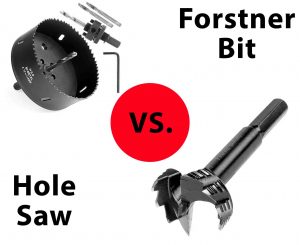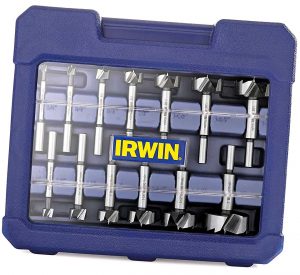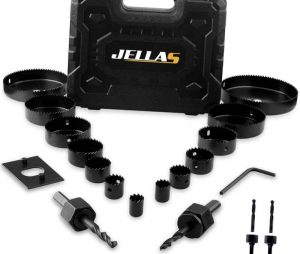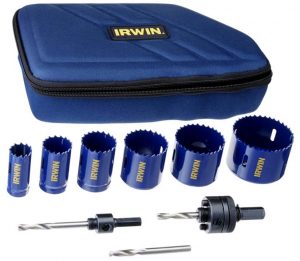Forstner Bit vs. Hole Saw: Which One to Use?

When I started stuffing my carpentry toolbox, Forstner bit vs. hole saw was quite an important and relevant issue. And now that I have both, I can share my experience with you.
Using Forstner bits
Forstner bits work great for anything needing high precision and a clean finish (see also best Forstner bit set review). They are also more “powerful” and with low speed and feed you can easily cut hardwood where hole saw will end up burning itself. The other pros of a Forstner bit is that it can drill as deep as you need. Of course, a hole saw cuts only as deep as the height of the bit allow.

All that is needed is to keep the bit sharp. Of course, anything beats a dull Forstner bit. Blunt edges splinter plywood, and tend to overheat quickly. As a result, the steel deteriorates and even after sharpening the bit does not work well. The best forstner bits will serve you for a very long time, you just need to work slowly and keep the tool sharp.
Fortunately, even if you are a complete novice when it comes to sharpening tools, you can sharpen a Forstner bits and it won’t take much. Just like a chisel, flatten and smooth the bottom, and then lightly sharpen the angle. It is convenient to use a small and smooth file. And although the bit may not become as sharp as brand new, but the difference will be huge!
Now I have own set of Forstner bits 1/8 – 3-1/4” in size and they are from a different manufacturers that I acquired over the years.
Hole Saw – works great if used properly
Hole saw is very useful instrument for construction and rough work. The tool leaves a rougher finish and worse and has less precision in diameter. It can easily be +/- 1/8″ or even more from the desired size.
I also often use my hole saw kit. Recently work with the tool on my drill press table build. Just put the tool on the drill press and cut the hole. It was chattering while cutting, but did the job with ease.

The hole saw cuts with more sawing action while the Forstner bit is more like a chisel. After drilling you just split the circular material with a screwdriver or a chisel and remove it.
You can drill out in one go only full depth of the saw. Further cutting becomes a problem, but it is doable. You can also use a dremel bit for cutting wood for final processing. I sharpen bits all the time. But hole saws are pretty cheap so it’s no big loss if its butchered while sharpening.
A hole saw is able to drill precise holes too. You have to account for the actual size of the resulting hole and not the stated size. But I prefer Forstner for fine work and use hole saws mainly for drilling a big starter hole in finished cabinets to cut in receptacles.
I use like Irwin hole saws since they seem to be the most precise. I’ve measured many of them with dial calipers in the store. The Irwin saws are also a lot easier to get the cut-out piece out of the bit after drilling.

Conclusion: Forstner Bit vs. Hole Saw
A hole saw is usually used for cutting through holes in thin material. Forstner drills are great for drilling clean, precise holes that can be blind and flat bottomed or go fully through the workpiece.
Hole saws are quite a bit cheaper than a Forstner bits and it does not cut the entire volume of material into shavings. Saw cuts the wood around the perimeter and this is often an advantage – you can make the hole faster and with less effort.
In general, the answer to Forstner bit vs. hole saw question depends on how large of a hole you need. For small diameter holes less than 1 3/4″ I prefer a Forstner bit. Larger diameters are easier to cut with hole saws. They sometimes create a lot of burn marks, so if for a better looking holes I use Forstners too.
With both tool types it is important to clamp the wood to the table whenever possible
Read also our “Forstner bit vs spade bit” article
Posted on Categories Drill Bits